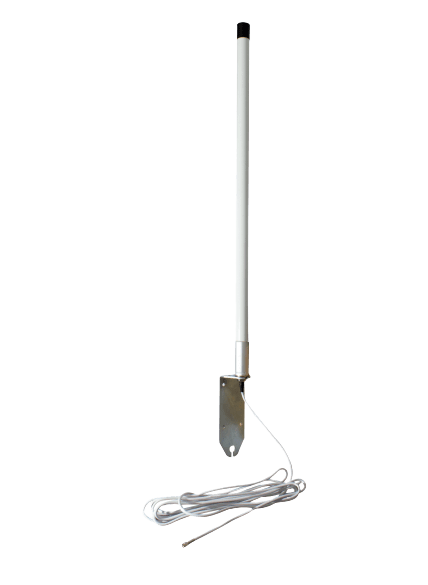
LoRa LPWAN IoT Antennas four hot products
LoRa LPWAN IoT Antennas are a hot topic right now and building out a reliable network based on 868 MHz or 915 MHz requires the deployment of quality antennas and accessories. Here we look at four robust antenna types to facilitate consistent and dependable installation.
High gain outdoor omni-directional antenna
On the edges of the network where signal strength cannot always be depended on, a quality outdoor antenna is often a go to solution. Common requirements for such antennna are be robust with the antenna and bracket built from quality components, offer high gain (5 dBi+) to provide a stable signal, be compact enough to be discreet and offer flexible mounting options. Combining these factors will deliver consistent performance whatever the climate conditions. A fine example of such an antenna is the WMO86916.
Wall-mount omni-directional antenna
Some external LoRA LPWAN IoT antennas are required because the antenna cannot, for one reason or another, be mounted directly onto the radio. For reasons of signal coverage, location of radio/terminal below ground or in a shielded area, willful damage or simply practicality, wall-mounted omni-directional antennas are often used. For most applications they need to be compact, discreet and cost-effective while offering robust RF performance. They also need to be easy to install in order to keep installation costs/time to minimum. Two excellent choices of such antennas are the Wall-Blade and the WCO-868-WMB. Both are very compact, easy to install and offer accomplished RF performance.
Low profile permanent mount puck antenna
Antennas are often required to mount directly onto a terminal or enclosure. Mostly permanently mounted by a threaded boss through which the cable is fed, they offer a secure and effective way to facilitate 868 MHz and 915 MHz communications. Such antennas need to be very compact with a durable radome, be of a material to withstand inclement weather, possess a durable mounting stud and offer reliable RF performance. Many of the small pucks, smaller means that they less likely to draw attention to themselves, are groundplane dependent i.e. they have to be mounted onto a metal surface. One such antenna is the Button 868 915 MHz antenna. This antenna is compact as it gets without compromising on RF performance.
Terminal/Radio-mounted dipole antenna
In cases where the antenna does not need to be mounted away from the radio or terminal, a dipole antenna can offer reliable RF performance when directly connected via a coaxial connector. This type of antenna is not the smallest, you can find small 1/4 wave antennas that are much more discreet, but they typically offer robust RF capabilities. Especially where no groundplane is available, for example if the terminal has a non-metal enclosure, the dipole style antenna can offer RF advantages over rival terminal antennas. In addition, do verify the build quality of such antenna so that you can be assured that it is built to last as inferior antennas can be very easily damaged thereby demanding costly engineer revisits. A good example of a quality dipole antenna is the BKR915 and the BKR868.
Aside from the antennas, it is wise to make sure that if you are running coaxial extension cables you use quality cables to minimise cable losses. At 868 MHz and 915 MHz for cable runs up to 10M, you could typically use RF195 type cable. From 10-20M it would be worth considering RF240. And for longer RF400 cable installations. Using inferior coaxial cable will negate the benefits of use quality antennas as signal losses across the inferior cables will be experienced.
Some of the antennas mentioned can be purchased via the Connex webshop.
